Wearable Motion Sensor Market Size
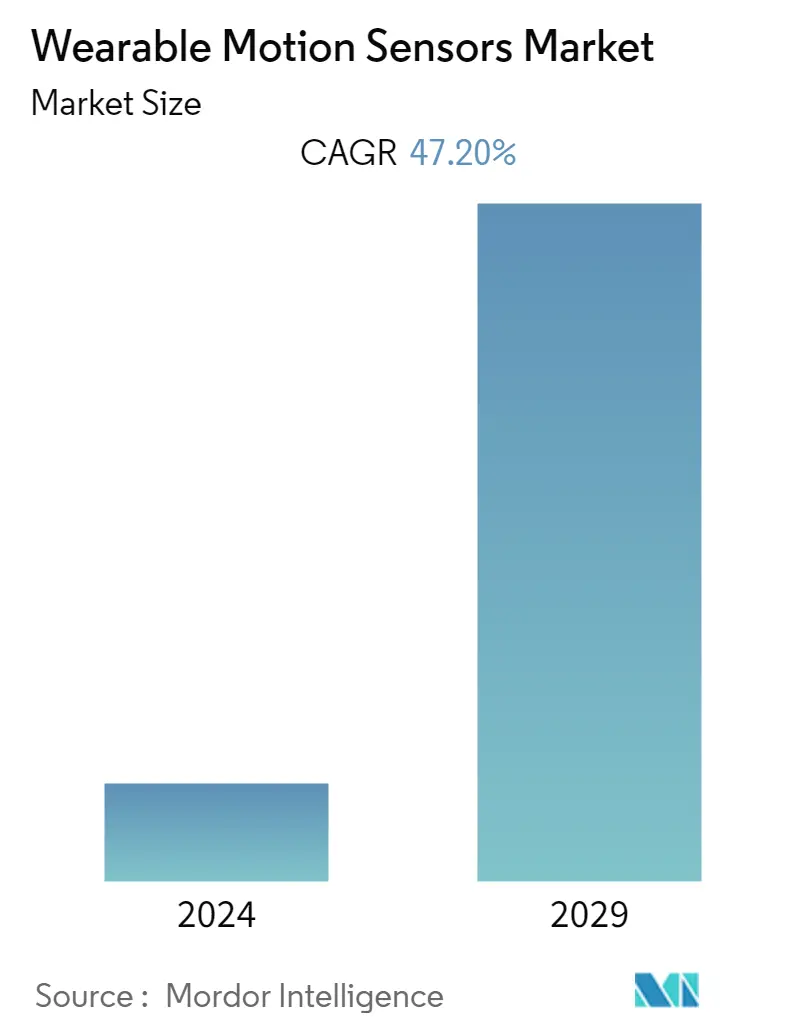
| Study Period | 2019 - 2029 |
| Base Year For Estimation | 2023 |
| CAGR | 47.20 % |
| Fastest Growing Market | Asia Pacific |
| Largest Market | North America |
| Market Concentration | Low |
Major Players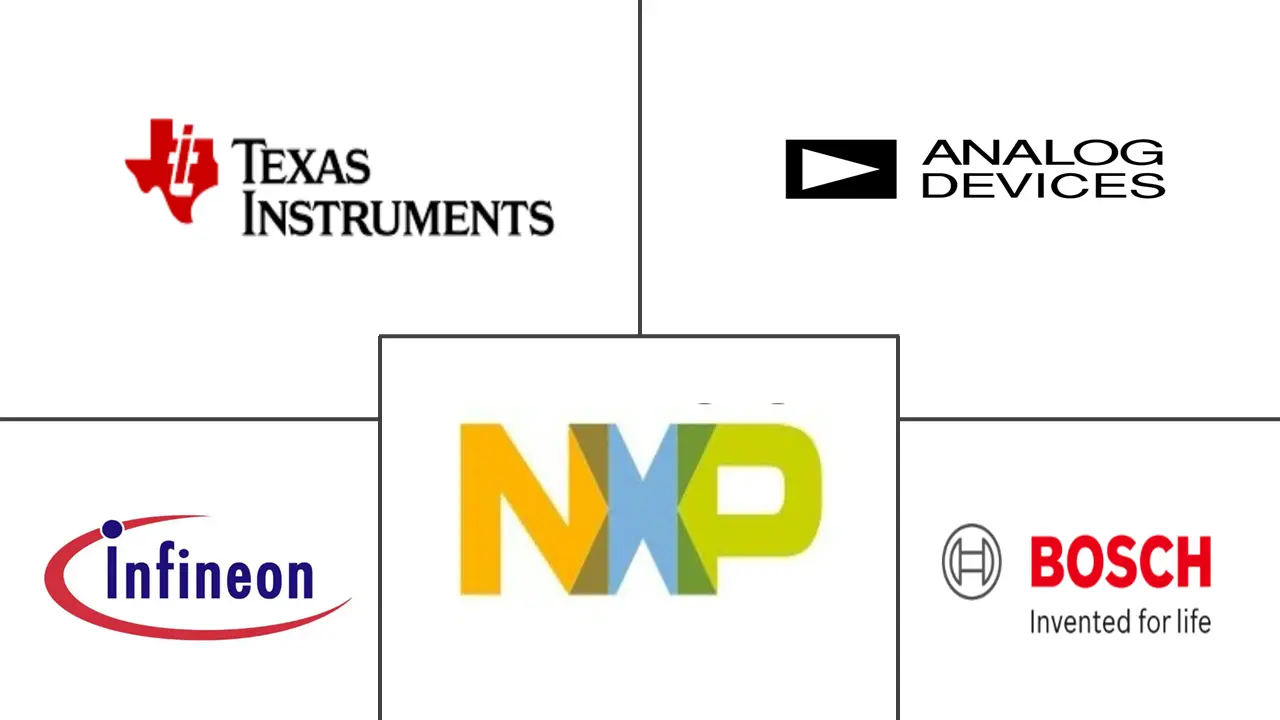
*Disclaimer: Major Players sorted in no particular order |
Wearable Motion Sensor Market Analysis
The Wearable Motion Sensors Market is expected to register a CAGR of 47.2% during the forecast period. Wearable products are expected to deliver valuable services to the owners to help drive a better lifestyle. Specifically, the wrist-worn wearable market requires OEMs to provide wellness and fitness-related services, a key reason the market traction for these devices is increasing quickly. Wearable devices with embedded motion sensors are used to enrich user experience in health and fitness by tracking an individual's physical activities, such as walking, running, and cycling.
- Motion sensors, such as gyroscopes, accelerometers, Microelectromechanical Systems (MEMS), and a combination of these sensors, are the most used type of wearables. Furthermore, health-tracking wearables always integrate motion and MEMS sensors but are not limited to and can also include health-specific sensors, like heart rate monitors, skin temperature sensors, and pulse monitors.
- The market for wearable motion sensors is being driven by the shrinking of sensors and related sensor components, increasing demand for sophisticated function sensors in wearable technology, advancements in battery size and efficiency.
- Due to consumers' increased interest in tracking real-time motion sensing activities, such as step counting and walking distance covered, sensors are an essential part of wearable devices used by consumers. The analysis of the generated data gives users specific results that can be used to define health and fitness goals.
- In particular, wearable motion sensors offer great potential for health-promoting interventions in the older population, patient care and research, and geriatric rehabilitation. Continuous health monitoring and integrated diagnostic devices worn on the body can help to identify and prevent early manifestations of age-related functional decline and disease.
- The COVID-19 pandemic positively impacted the wearable motion sensors market and highlighted the need to harness and leverage the digital infrastructure for remote patient monitoring. As current viral tests and vaccines are slow to emerge, there is a need for more robust disease detection and tracking of individual and population health, which wearable motion sensors could aid.
Wearable Motion Sensor Market Trends
This section covers the major market trends shaping the Wearable Motion Sensors Market according to our research experts:
Consumer Electronics Segment to Hold Significant Market Share
- The micro-electro-mechanical sensors (MEMS) that have been developed for wearables as technology has advanced and are influenced by the impact of smartphones being used daily, such as GPS or inertial measuring unit (composed of accelerometer, gyroscope, and magnetometer) sensors. This has helped fitness-tracking wearables revolve around these sensors exclusively.
- For instance, Nintendo Switch Labo edition Joy-cons possess default sensors in the accelerometer and gyroscope, which are usually found in consumer wearables. Joy-cons and cardboard combine to build artificial wearables, such as robots, to apply to a gaming function. It is usually Nintendo's way of breaking barriers for future generations (who are more involved with technology at younger ages) in immersive experiences with simplified custom wearable tech.
- Accelerometers are motion sensors used in wearables. Their brand of acceleration, such as gravity and linear, demonstrates their sensing capabilities. Meanwhile, their measuring ability enables the programming of measured data for different purposes. For instance, a user who runs can access their top speed output along with acceleration. Further, accelerometers can track sleep patterns like smartwatches and wristbands, thus driving the demand for wearable motion sensors in the consumer electronics segment.
- An accelerometer sensor takes inertial measurements of position and velocity. Usually, on three axes, it can sense the body's inclination, tilt, and orientation. Naturally, this is very important for any fitness tracker as most steps taken by the individual will be recorded by this sensor. The increase in demand for fitness trackers and wellness monitors is a crucial factor driving the demand for wearable motion sensors in consumer electronics.
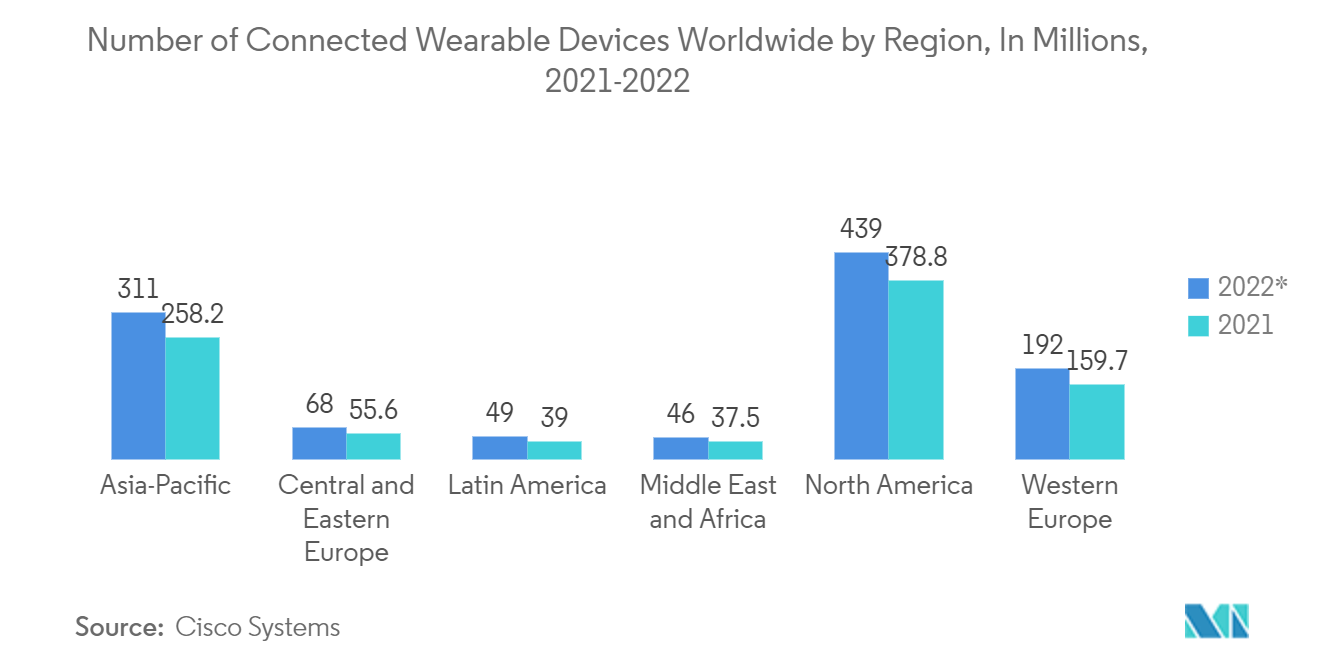
Asia-Pacific to Witness the Significant Growth
- The Asia-Pacific region is expected to witness significant growth during the forecast period, owing to increased awareness of wearable devices and rapid urbanization. Furthermore, this region is home to some of the significant manufacturers of sensors and semiconductors, which is expected to propel the market growth further.
- Several big enterprises and various new players in countries like Japan and China are investing hugely in sensor technology advancement due to the adoption of different wearable fitness and health tracking devices among people and their growing popularity. With the development of precise sensing technologies and the miniaturization of sensor technology in wearables from original equipment manufacturers in the Asia-Pacific region, the market is anticipated to grow even further.
- In September 2021, IIT Guwahati researchers developed a novel water-repellent material for real-time monitoring of human movements. Wearable motion sensors are used explicitly for the physiological monitoring of human activity. These sensors are used for gait analysis, understanding human and machine interactions, and monitoring patients during rehabilitation. Such motion sensors are typically made of materials that convert the mechanical strain from movement into electrical signals that can be detected.
- Also, Original Equipment Manufacturers (OEMs) are making a significant contribution to the development of inertial measurement units and MEMS technology to provide greater accuracy while keeping the price lower for these products, which is one of the factors for the increased adoption of wearables in this region.
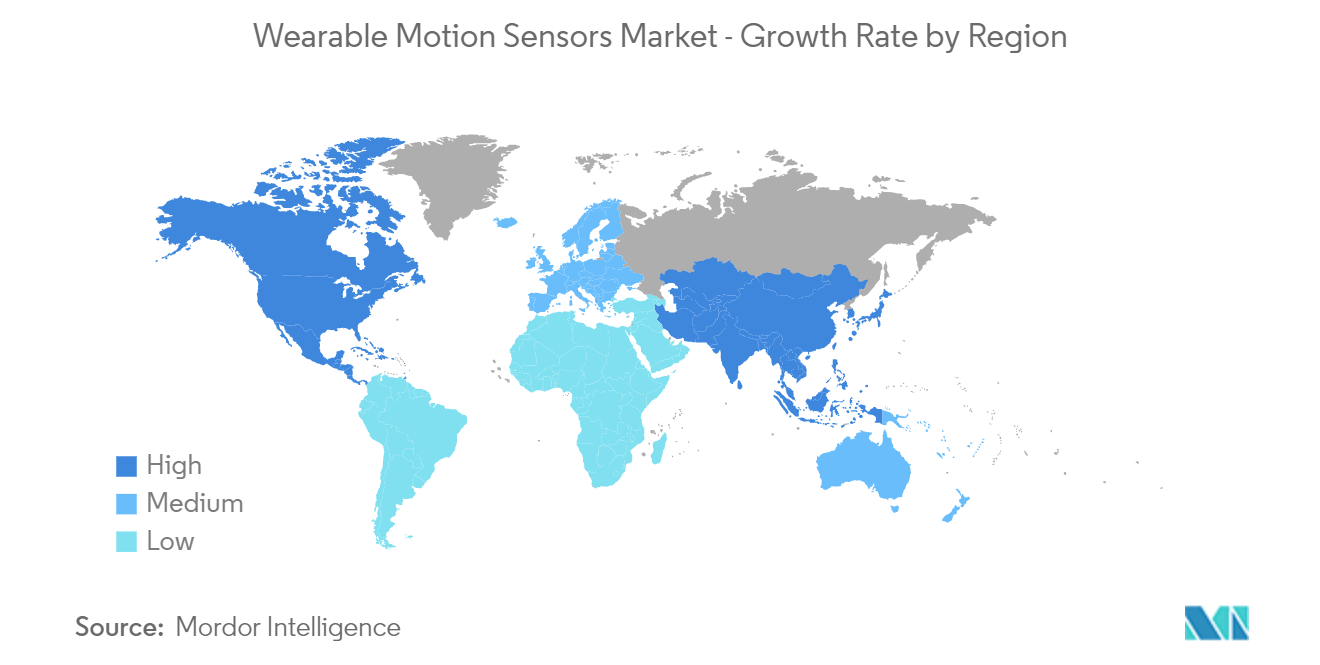
Wearable Motion Sensor Industry Overview
The Wearable Motion Sensors Market is very competitive in nature. The market is highly concentrated due to the presence of various small and large players. All the major players account for a large share of the market and are focusing on expanding their consumer base across the world. Some of the significant players in the market are Panasonic Industry Co., Ltd., Texas Instruments Incorporated, Analog Devices, Inc., General Electric, Samsung Electronics Co. Ltd, TDK Corporation, Infineon Technologies AG, NXP Semiconductors, and many more. The companies are increasing the market share by forming multiple partnerships and investing in introducing new products, earning a competitive edge during the forecast period.
In September 2022, analog devices and HSU researchers collaborated on a wearable device for seizure detection. Study participants wore the watch on their wrist, where multimodal sensors such as an accelerometer, thermometer, a sensor to measure electrical changes in the skin, and additional biometric sensors, recorded physiological data in real-time. The researchers tested whether the watch could correlate the data to the EEG measurements to determine the presence of focal to bilateral tonic-clonic seizures. The project's long-term goal is to build machine learning algorithms to better identify a patient's seizures and eventually develop predictive software for the watch that will warn individuals (and caregivers and families) about a forthcoming seizure.
In May 2022, Qeexo, the developer of the Qeexo AutoML, collaborated with Bosch Sensortec GmbH, a technology leader in MEMS sensing solutions, and announced that machine learning algorithms created using Qeexo's AutoML can now be deployed on Arduino Nicla Sense ME with Bosch BHI260AP and BME688 sensors. Using the Qeexo AutoML, Machine Learning (ML) models that would otherwise run on the host processor-can be deployed in and executed by BHI260AP and BME688. For instance, they can monitor environmental parameters, including humidity and Air Quality Index (AQI), and capture information embedded in motion, such as person-down systems to fitness apps that check posture. These devices have a longer time between charges and provide actionable information.
Wearable Motion Sensor Market Leaders
-
Texas Instruments Incorporated
-
Analog Devices Inc.
-
Infineon Technologies AG
-
NXP Semiconductors
-
Bosch Sensortec GmbH
*Disclaimer: Major Players sorted in no particular order
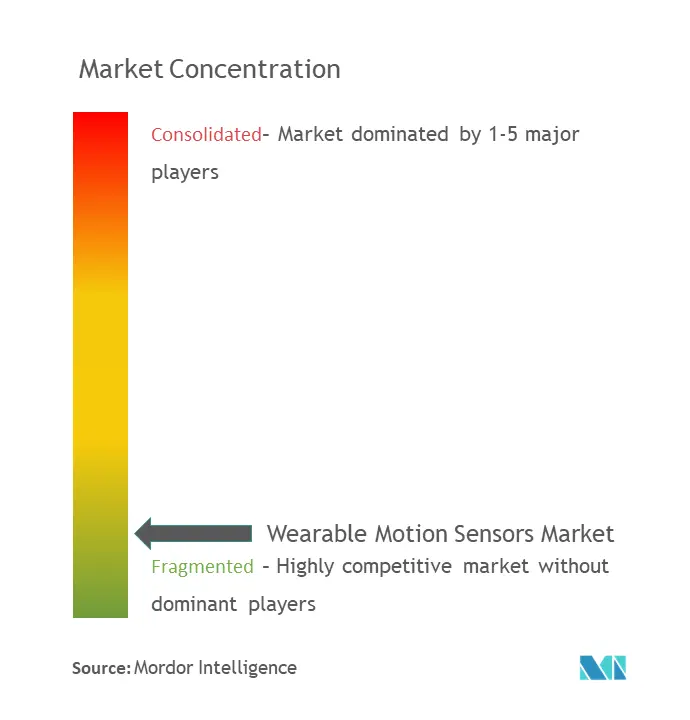
Wearable Motion Sensor Market News
- May 2022: Analog Devices Inc announced a three-axis MEMS accelerometer for various healthcare and industrial applications, including vital signs monitoring, hearing aids, and motion-enabled metering devices. The ADXL367 accelerometer improves power consumption by two times versus a previous generation of the device (ADXL362) while improving noise performance by up to over 30%. The new accelerometer also provides extended field time that maximizes battery life and reduces maintenance frequency and cost. The features include 200 nW motion detection in wakeup mode and 970 nW in measurement.
- January 2022: TDK Corporation announced the availability of the InvenSense ICM-45xxx SmartMotion ultra-high-performance (UHP) family of 6-axis MEMS motion sensors. This family introduces the on-chip self-calibration, the industry's lowest power consumption, and the world's first BalancedGyro (BG) technology. BG technology by TDK comprises MEMS architecture that enables maximum vibration rejection and temperature stability performance, a unique enhancement in a consumer gyroscope. In addition, relative to competitors, the ICM-45xxx family offers the world's lowest power 6-axis motion sensors. The ICM-45xxx allows the gyroscope to be on 40% of the time, more than any IMU in the industry.
Wearable Motion Sensor Market Report - Table of Contents
1. INTRODUCTION
- 1.1 Study Assumptions and Market Definition
- 1.2 Scope of the Study
2. RESEARCH METHODOLOGY
3. EXECUTIVE SUMMARY
4. MARKET INSIGHTS
- 4.1 Market Overview
-
4.2 Industry Attractiveness - Porter's Five Forces Analysis
- 4.2.1 Bargaining Power of Suppliers
- 4.2.2 Bargaining Power of Consumers
- 4.2.3 Threat of New Entrants
- 4.2.4 Threat of Substitutes
- 4.2.5 Intensity of Competitive Rivalry
- 4.3 Impact of COVID-19 on the Wearable Motion Sensors Market
5. MARKET DYNAMICS
-
5.1 Market Drivers
- 5.1.1 Increasing Health Awareness
- 5.1.2 Growing Demand for Wearable Fitness Monitors
-
5.2 Market Challenges
- 5.2.1 High Cost of the Devices
6. MARKET SEGMENTATION
-
6.1 By Type
- 6.1.1 Accelerometers
- 6.1.2 Inertial Gyroscopes
- 6.1.3 MEMS
-
6.2 By Application
- 6.2.1 Smart Watches
- 6.2.2 Fitness Bands
- 6.2.3 Activity Monitors
- 6.2.4 Smart Clothing
- 6.2.5 Sports Gear
-
6.3 By End-user Industry
- 6.3.1 Healthcare
- 6.3.2 Sports/Fitness
- 6.3.3 Consumer Electronics
- 6.3.4 Entertainment and Media
- 6.3.5 Government and Public Utilities
-
6.4 By Geography
- 6.4.1 North America
- 6.4.1.1 United States
- 6.4.1.2 Canada
- 6.4.2 Europe
- 6.4.2.1 United Kingdom
- 6.4.2.2 Germany
- 6.4.2.3 France
- 6.4.2.4 Rest of Europe
- 6.4.3 Asia Pacific
- 6.4.3.1 China
- 6.4.3.2 Japan
- 6.4.3.3 India
- 6.4.3.4 Rest of Asia Pacific
- 6.4.4 Latin America
- 6.4.4.1 Brazil
- 6.4.4.2 Argentina
- 6.4.4.3 Rest of Latin America
- 6.4.5 Middle East and Africa
- 6.4.5.1 United Arab Emirates
- 6.4.5.2 Saudi Arabia
- 6.4.5.3 Rest of Middle East & Africa
7. COMPETITIVE LANDSCAPE
-
7.1 Company Profiles
- 7.1.1 Panasonic Industry Co., Ltd.
- 7.1.2 Texas Instruments Incorporated
- 7.1.3 Analog Devices, Inc.
- 7.1.4 General Electric
- 7.1.5 Samsung Electronics Co. Ltd
- 7.1.6 TDK Corporation
- 7.1.7 Infineon Technologies AG
- 7.1.8 NXP Semiconductors
- 7.1.9 Bosch Sensortec GmbH
- 7.1.10 Xsens
- 7.1.11 Zoll Medical Corporation
- *List Not Exhaustive
8. INVESTMENT ANALYSIS
9. FUTURE OF THE MARKET
** Subject To AvailablityWearable Motion Sensor Industry Segmentation
A motion sensor detects the movement of a human being or an object concerning the external environment. A wearable motion sensor may track a person's movement and record the information, which can then be analyzed. It records a person's movements using gyroscopes and accelerometers.
The Wearable Motion Sensors Market is segmented by Type (Accelerometers, Inertial Gyroscopes, MEMS), by Application (Smart Watches, Fitness Bands, Activity Monitors, Smart Clothing, Sports Gear), by End-user Industry (Healthcare, Sports/Fitness, Consumer Electronics, Entertainment and Media, Government and Public Utilities), and by Geography (North America (United States, Canada), Europe (Germany, United Kingdom, Italy, France, and Rest of Europe), Asia-Pacific (China, Japan, India, and Rest of Asia-Pacific), Latin America (Brazil, Argentina, and Rest of Latin America), and Middle East and Africa (United Arab Emirates, Saudi Arabia, and Rest of Middle East & Africa)). The market sizes and forecasts are provided in terms of value (USD million) for all the above segments.
| By Type | Accelerometers | |
| Inertial Gyroscopes | ||
| MEMS | ||
| By Application | Smart Watches | |
| Fitness Bands | ||
| Activity Monitors | ||
| Smart Clothing | ||
| Sports Gear | ||
| By End-user Industry | Healthcare | |
| Sports/Fitness | ||
| Consumer Electronics | ||
| Entertainment and Media | ||
| Government and Public Utilities | ||
| By Geography | North America | United States |
| Canada | ||
| By Geography | Europe | United Kingdom |
| Germany | ||
| France | ||
| Rest of Europe | ||
| By Geography | Asia Pacific | China |
| Japan | ||
| India | ||
| Rest of Asia Pacific | ||
| By Geography | Latin America | Brazil |
| Argentina | ||
| Rest of Latin America | ||
| By Geography | Middle East and Africa | United Arab Emirates |
| Saudi Arabia | ||
| Rest of Middle East & Africa |
Wearable Motion Sensor Market Research FAQs
What is the current Wearable Motion Sensors Market size?
The Wearable Motion Sensors Market is projected to register a CAGR of 47.20% during the forecast period (2024-2029)
Who are the key players in Wearable Motion Sensors Market?
Texas Instruments Incorporated, Analog Devices Inc., Infineon Technologies AG, NXP Semiconductors and Bosch Sensortec GmbH are the major companies operating in the Wearable Motion Sensors Market.
Which is the fastest growing region in Wearable Motion Sensors Market?
Asia Pacific is estimated to grow at the highest CAGR over the forecast period (2024-2029).
Which region has the biggest share in Wearable Motion Sensors Market?
In 2024, the North America accounts for the largest market share in Wearable Motion Sensors Market.
What years does this Wearable Motion Sensors Market cover?
The report covers the Wearable Motion Sensors Market historical market size for years: 2019, 2020, 2021, 2022 and 2023. The report also forecasts the Wearable Motion Sensors Market size for years: 2024, 2025, 2026, 2027, 2028 and 2029.
Motion Sensor Industry Report
Statistics for the 2024 Motion Sensor market share, size and revenue growth rate, created by Mordor Intelligence™ Industry Reports. Motion Sensor analysis includes a market forecast outlook 2029 and historical overview. Get a sample of this industry analysis as a free report PDF download.



